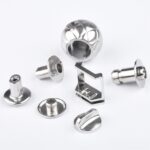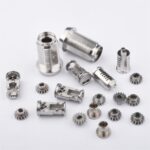The Beginners Guide To CNC Turning
If you’re interested in starting a career in the machining and fabricating industry, then you’ll need to be familiar with CNC turning. In this article, we’ll be walking you through the basics of CNC turning and how it can benefit your career. So whether you’re just getting started or you’ve been working with CNC machines for a while, read on to learn more!
What is CNC Turning?
CNC turning is a cutting process that uses a computer-controlled milling machine to produce intricate cuts in metal or plastic. The results are often precision-made parts that can be customized to exact specifications.
If you’re interested in learning more about this fascinating process, we’ve put together a beginner’s guide to help you get started. In this guide, we’ll discuss the basics of CNC turning, explain the different types of mills and how they work, and introduce you to some of the most popular software programs used for CNC turning. So be sure to read on if you want to learn more about CNC turning!
Types of CNC Turning
In this blog post, we will discuss the different types of CNC turning and give you a basic understanding of what they entail. We will also provide a brief overview of the technologies involved and their benefits. Finally, we will suggest some resources that may be helpful for those interested in learning more about CNC turning.
Types of CNC Turning
There are three main types of CNC turning: manual turning, automatic turning, and hybrid turning. Manual turning is the oldest form of CNC turning and typically requires the most skill and effort from the user. Automatic turning is a newer technology that uses sensors to control the movement of the machine tool, making it faster and more accurate than manual turning. Hybrid turning combines elements of both manual and automatic turning to create an optimal solution for the user.
Cutting Tools
When starting out with CNC turning, the first step is to choose the right cutting tools. This can be a bit daunting as there are so many options available. In this article, we will discuss the different types of cutting tools and recommend some of the best ones for beginners.
First and foremost, it is important to understand that not all tools are created equal when it comes to CNC turning. Different materials will require different types of cutting tools in order to achieve the desired results.
For example, if you are trying to cut wood, you will need a woodcutting saw. Saw blades are designed specifically for this purpose and they will get the job done quickly and easily. If you want to cut other materials, such as plastic or metal, you will need a different tool.
In general, there are four main types of cutting tools: straight edge saws, jigsaws, rotary tools and CNC routers. Each has its own benefits and drawbacks so it is important to choose the right one for the job at hand.
Here are some of the best options for beginner CNC turners:
1) Straight Edge Saws: Straight edge saws are perfect for cutting wooden boards
Working with G-code
If you’re new to CNC turning, or just haven’t used a CNC machine in a while, it can be a bit daunting to get started. In this blog post, we’ll outline the basics of working with G-code, and show you how to get started using a CNC machine.
First things first: what is G-code? G-code is a digital format used for controlling the motion of machines like CNC machines. It’s simple enough for beginners to use, but powerful enough to create high-quality parts.
To start using G-code, you’ll need a computer with software that supports it. Luckily, most modern machines come with software preinstalled. If not, there are many freely available options online. Once you have G-code support on your computer, you’re ready to start learning how to use it!
Here’s a quick overview of the most common commands in G-code:
Rotate: This command rotates the machine around its central axis (usually called Z). You can use degrees (DEG), radians (RAD), or turns (TURN).
Movement Speed: This specifies how fast the machine should move
Facing the CAM Processor
If you’re new to the world of computer-aided manufacturing (CAM), then you likely have a lot of questions. In this beginners guide, we will address some of the most common ones, starting with the basics of what a CAM processor is and how it works. We will then discuss some popular CAM software programs and how to use them. Finally, we will offer tips on how to get started with CAM turning.
What is a CAM Processor?
A CAM processor is essentially a computer that has been specifically designed for creating 3D models and drawings using CAM software. The processor can be used to control the various functions of the software, such as creating parts, assemblies, and 3D models. Additionally, many modern processors come with features that make them ideal for creating digital machining plans or data files for CNC machines.
How Does a CAM Processor Work?
When you open up a CAD program such as SketchUp or Revit and start drawing something onscreen, what you’re actually doing is sending instructions to your computer in the form of G-code. G-code is essentially a set of instructions that tells your machine what to do, from
Machining Processes
There are a variety of machining processes that can be used in the production of parts and products. In this article, we will discuss the basics of CNC turning, which is a popular machining process.
If you are just starting out in the machining world, or if you are looking to learn more about a specific process, our blog section is a great place to start. Here, we will cover topics such as CNC turning basics, types of tools and machines used for CNC turning, and how to choose the right machine for your project.
So whether you are looking to learn more about CNC turning or just want to brush up on your knowledge of the process, be sure to check out our blog section!
Tool selection
When it comes to choosing the right tools for your CNC turning project, there are a few factors you need to consider. The most important factor is the type of material you’re working with. For example, if you’re turning small parts out of hardwood or metal, you’ll likely want a handheld tool like a jigsaw or saw. If you’re working with plastic or other soft materials, though, an electric CNC router will be more efficient and accurate.
Another important factor is the size and shape of the parts you’ll be turning. If they’re small, a handheld tool will be fine. But if your parts are larger or more complex, you’ll need something like an electric CNC router. And finally, you need to decide what type of cutting edge you want on your tool – a straight edge for woodworking or a rabbet for metal work.
Once you have all of your tools figured out, it’s time to start learning how to use them! There are plenty of online tutorials available that will walk you through the basics of using each tool. Once you feel comfortable using your tools, it’s time
Conclusion
If you’re looking to jump into the world of CNC turning, this guide is for you. In it, we’ll cover everything from the basics of CNC turning tools and software to tips for making your first cuts. By the end of this guide, you should have a firm understanding of what CNC turning is and why it might be a good fit for your project(s). So put on your learning cap and let’s get started!









